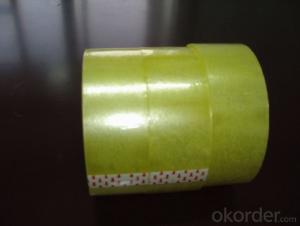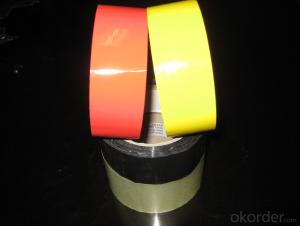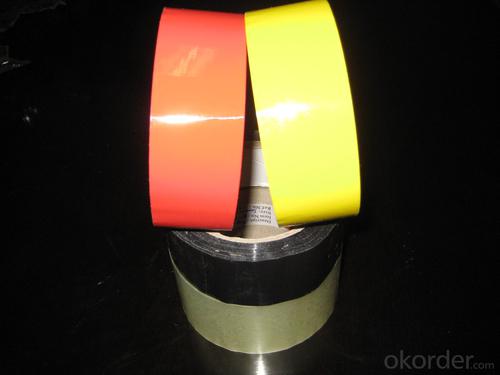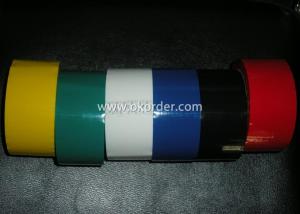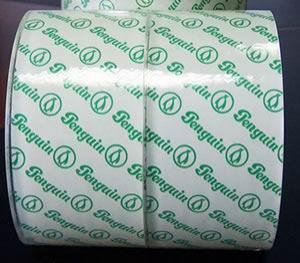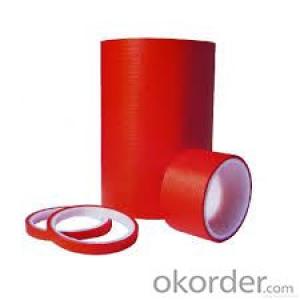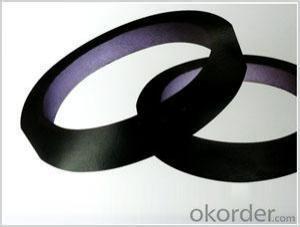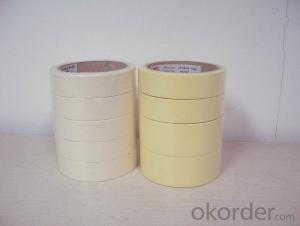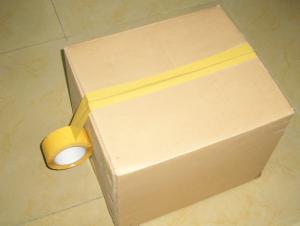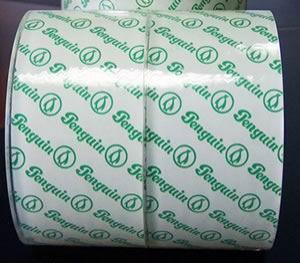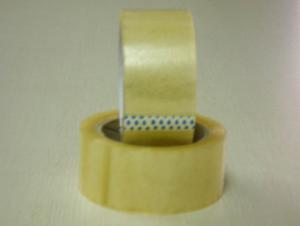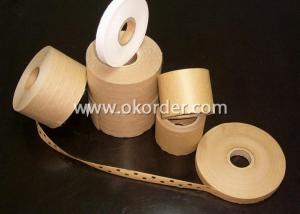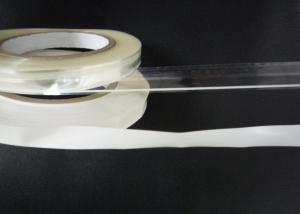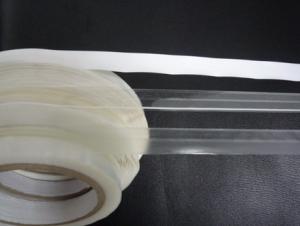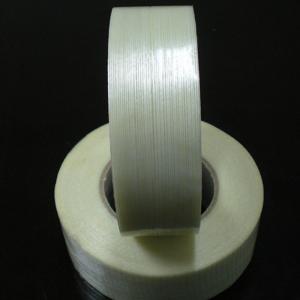Scotch Kraft Super Clear BOPP Packing Tape
- Loading Port:
- China Main Port
- Payment Terms:
- TT OR LC
- Min Order Qty:
- -
- Supply Capability:
- -
OKorder Service Pledge
OKorder Financial Service
You Might Also Like
CONSTRUCTION:
Carrier: BOPP film
Adhesive: Water based acrylic adhesive.
TYPICAL PHYSICAL PROPERTIES:
Total Thickness (adhesives + carrier): 40 ± 2 um
Initial Tack (11mm steel ball): ³ 18#
180O Peel Adhesion (to steel): ³ 0.5 kgf /25mm
Holding Power: ³ 24 hrs
Tensile Strength: ³ 30 N/cm
Elongation: ≤180%
PACKING:
Core I.D.: 3” (76mm±1)
Jumbo Roll:1280mm x 4000m
Cut Roll: As per customer’s requirements
Application:
Carton sealing & packing, Light duty packaging, bundling, holding, and other office & household use.
REMARKS:
1. The data above are typical results and subject to change without notice.
2. Tolerance: Weight and Thickness: ±10%; Width: ±3mm;
Length: Cut Roll & Log Roll ±0.3m, Jumbo Roll ±0.5%.
3. The products should be stored at room temperature and be kept away wet and/or heat source.
4. It is essential, as with all pressure-sensitive tapes, that the surface to which the tape is applied must be clean, dry, and free of grease and oil.
5. The users should take test and do trial-application on the above products before coming into application so as to witness and ensure suitability for their special purpose and technique.
- Q: What is the difference between acrylic and hot melt adhesive for packaging tape?
- The main difference between acrylic and hot melt adhesive for packaging tape lies in their composition and performance. Acrylic adhesive is made from water-based acrylic polymers and offers excellent clarity and UV resistance. It is ideal for long-term storage and can withstand temperature fluctuations. Hot melt adhesive, on the other hand, is a synthetic rubber-based adhesive that provides instant bonding and superior tack. It is suitable for applications requiring immediate adhesion and performs well in high-temperature environments. Overall, the choice between acrylic and hot melt adhesive depends on the specific packaging needs and conditions of use.
- Q: Can packaging tape be used for sealing perishable food items?
- Using packaging tape to seal perishable food items is not recommended. This is because packaging tape is typically made of materials like polypropylene or PVC, which are not suitable for food safety and may contaminate the food. Additionally, packaging tape is not designed to create an airtight seal, which is essential for preserving the freshness and preventing spoilage of perishable food items. To ensure the safety and quality of perishable food items, it is advisable to use appropriate food-safe sealing methods such as ziplock bags, airtight containers, or food-grade cling wrap.
- Q: Can packaging tape be used for sealing arts and crafts materials?
- Yes, packaging tape can be used for sealing arts and crafts materials. It provides a strong and secure bond, making it suitable for various types of materials such as paper, cardboard, and plastic. However, it is important to consider the aesthetics and longevity of the tape, as there may be more specialized options available for specific art and craft projects.
- Q: How about the price of tape?
- Each tape price calculation method: the tape industry usually use "yuan / square meter" to calculate the price of adhesive tape, calculate the price of adhesive tape formula: "each tape price = width (m) * length (m) * square price"". The price of the adhesive tape needs to be variable according to the cost, because the BOPP film and glue belong to the petroleum products, and the price is uncertain.
- Q: What is the purpose of packaging tape?
- Packaging tape serves the purpose of securely sealing and reinforcing packages, boxes, or containers during storage, transportation, or shipping. Its design ensures a strong and long-lasting bond that keeps the package contents intact and protected. Furthermore, it acts as a clear indicator of tampering, allowing for easy identification of any unauthorized opening or interference. Additionally, it safeguards the package from dust, moisture, and other external elements, thereby maintaining the integrity and quality of the enclosed items. In summary, packaging tape plays a crucial role in providing a dependable and efficient solution for sealing and safeguarding packages, making it an indispensable tool for businesses, individuals, and organizations engaged in shipping and logistics.
- Q: Can packaging tape be used for sealing plastic bottles?
- Yes, packaging tape can be used for sealing plastic bottles.
- Q: Can packaging tape be used for sealing metal boxes?
- Yes, packaging tape can be used for sealing metal boxes. Packaging tape is designed to provide a secure and durable seal on various surfaces, including metal. It offers a strong adhesive that can effectively stick to metal surfaces, ensuring that the box remains sealed during transportation or storage. However, it is important to choose a packaging tape that is suitable for heavy-duty applications and can withstand the weight and pressure that may be exerted on the metal box. Additionally, it is recommended to clean the metal surface before applying the tape to ensure proper adhesion.
- Q: What is the average width of packaging tape?
- Packaging tape usually has an average width ranging from 1.88 inches to 2 inches. This standardized width ensures effective sealing of boxes and packages, ensuring a secure and dependable closure. Nevertheless, it is worth noting that the market offers different tape widths to cater to specific packaging requirements or personal preferences, with some tapes being narrower or wider.
- Q: Does packaging tape have any specific certifications or standards?
- Yes, packaging tape can have specific certifications or standards. There are various organizations and standards that set guidelines for packaging materials, including packaging tape. One of the most common certifications for packaging tape is the International Organization for Standardization (ISO) certification. ISO sets standards for quality management systems, and packaging tape can be certified under ISO 9001:2015, which ensures that the product meets certain quality criteria. In addition to ISO certification, packaging tape can also adhere to specific industry standards such as ASTM International standards or European Union directives. ASTM International develops and publishes technical standards for a wide range of materials, including packaging tape. These standards ensure that the tape meets specific requirements related to strength, adhesion, and durability. Furthermore, some packaging tapes may have certifications related to their environmental impact. For example, certain tapes may be certified as recyclable, biodegradable, or made from sustainable materials. These certifications can be obtained from organizations like the Forest Stewardship Council (FSC) or the Sustainable Forestry Initiative (SFI), which promote responsible forestry practices. It is important to note that not all packaging tapes will have certifications or adhere to specific standards. However, if a packaging tape does have certifications or complies with certain standards, it signifies that the product meets certain quality, performance, or environmental criteria.
- Q: How does packaging tape perform in high humidity environments?
- Packaging tape tends to work effectively in environments with high humidity, although its performance depends on the specific type and quality of the tape. Most packaging tapes are designed to withstand moisture and humidity to some degree, as they are commonly used in various climates and conditions. However, extended exposure to high humidity can weaken the adhesive properties of the tape, causing it to lose its effectiveness in sealing packages. In environments with high humidity, the moisture in the air can have an impact on the tape's ability to securely adhere. The adhesive on the tape may become less sticky or fail completely, resulting in the tape peeling off or losing its grip on the packaging. This can lead to packages becoming unsealed, potentially resulting in damage or loss of contents during transportation or storage. To minimize the effects of high humidity, it is advisable to use packaging tapes specifically designed for such conditions. There are tapes available that have been specifically formulated with adhesives resistant to moisture or have been reinforced with additional layers to enhance their strength and durability in humid environments. These tapes are capable of maintaining their adhesive properties even when faced with high levels of humidity. It is also important to store packaging tapes properly in a controlled environment with low humidity when they are not being used. Exposure to excessive moisture or humidity can negatively impact the tape's performance even before it is applied to packages. Storing the tape in a cool and dry place can help preserve its integrity and ensure it remains effective when needed. In conclusion, although packaging tape generally performs well in high humidity environments, it is essential to consider the quality and type of tape being used. Opting for moisture-resistant or reinforced tapes and storing them appropriately can help maintain their effectiveness in sealing packages, even in challenging humidity conditions.
Send your message to us
Scotch Kraft Super Clear BOPP Packing Tape
- Loading Port:
- China Main Port
- Payment Terms:
- TT OR LC
- Min Order Qty:
- -
- Supply Capability:
- -
OKorder Service Pledge
OKorder Financial Service
Similar products
Hot products
Hot Searches
Related keywords
